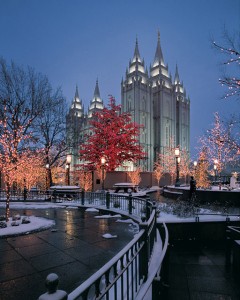The process of Mormon emigration began in the 1830’s and assisted 5,000 European converts in migrating to Nauvoo, Illinois. Beginning in 1846, the Mormon Church organized 16,000 persons in and around Nauvoo to make the great trek to Winter Quarters, Nebraska, and later to the Salt Lake Valley. By 1890 agents of the Mormon Church had directed the migration of 83,000 European members to the Salt Lake Valley. Scholars have regarded the Church’s arrangements as perhaps the best system of regulated immigration in U.S. history. Often immigrants newly arrived in Salt Lake City were first put to work building the kingdom by means of a public works system. Centered on Temple Square in Salt Lake City, the Mormon Church Department of Public Works provided employment for immigrants during their first winter in the Salt Lake Valley. They added such useful structures to the commonwealth as roads, walls, meetinghouses, railroads, telegraph lines, canals, the Salt Lake theatre, and the famous Salt Lake Temple and tabernacle.Each person was to have property sufficient to support his family, while any surplus belonged to the Lord’s storehouse. Property rights were granted conditionally and were not protected if the owner refused to utilize or develop the property.
 The speculative withholding of land from use was prohibited, and the purchase or appropriation of town lots simply for the sake of the increase in value was prevented. Hoarding money was also against Mormon Church rules.
The speculative withholding of land from use was prohibited, and the purchase or appropriation of town lots simply for the sake of the increase in value was prevented. Hoarding money was also against Mormon Church rules.
The goal of Mormon colonization and resource development, and of the Mormon village itself, was economic independence: The Mormon commonwealth was to be financially and economically self-sufficient.
The principles of this revelation were applied often and broadly. In the Great Basin, the Mormons were asked to manufacture their own iron, produce their own cotton, spin their own silk, and grind their own grain—all without borrowing from “outsiders.” It was reasoned that self-sufficiency was a practical policy because God had blessed each region with the resources necessary for the use of the people and the development of that region. As a result of the application of this principle, the Great Basin was the only major region of the United States whose early development was largely accomplished without outside capital.
Officially sponsored projects for self-sufficiency included an iron mission, consisting of about 200 families called by the Mormon Church who devoted strenuous efforts to developing the iron and coal resources near Cedar City; a sugar mission, in which several hundred people were united in the 1850s in an effort to establish the sugar-beet industry in Utah; a lead mission, in which some fifty men were called to work lead mines near Las Vegas, Nevada, to provide lead for paint and bullets; a cotton mission, which sent more than a thousand families to southern Utah to raise cotton, olives, grapes, indigo, grain sorghum, and figs; and silk missions, which involved the growing of mulberry trees and establishment of a silk industry in every suitable community.